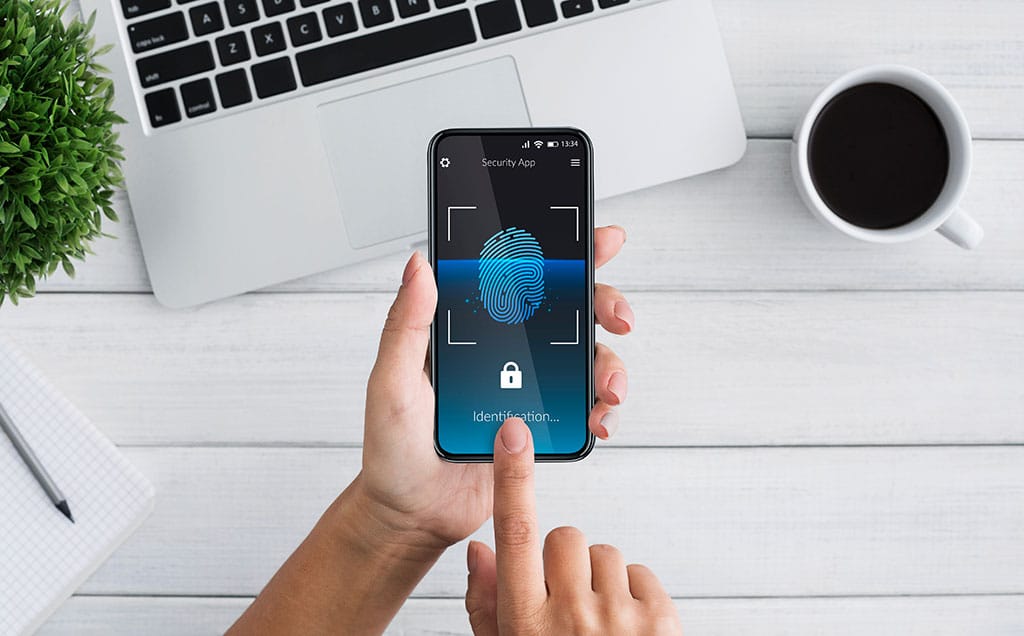We keep tabs on biometric security (using biological features like fingerprints and faces) because of its growth potential for the alarm and security industry. From limited commercial uses to common security features on laptops to everyday locks on our phones, biometric security has grown increasingly common.
While biometrics used to be a niche case for alarm installers, it’s now becoming a more common feature on security systems of all kinds. That includes the systems small businesses may want to install, or even home security and access control. Let’s look at the current trends driving biometric security and how it’s being adopted in the broader security market.
Smartphone Integration
Past biometric security relied on fingerprint scanners or cameras to enable additional authentication or unlock access points. Now that these capabilities are found on our phones, a new option is rising – biometrics via app. This is especially popular in home security. Users connect their security app to their phone, then use the phone’s face scan or fingerprint scan technology when they’re close to their door. The phone automatically unlocks the door when it recognizes the login attempt.
With this approach, users don’t have to input a code, or worry about security if they lose their phone (and it offers more control than using a Bluetooth connection). Add the ability for digital wallets to store electronic versions of security cards, and businesses can offer similar access control via approved phones. This saves time and significant expenses on additional devices.
Growing “Zero Trust” Practices
Zero Trust is a term for a broad 2020s trend that basically means, “Always account for human error.” Security cards can be stolen, doors can be left open, companies can harvest and use personal data, and employees can steal. Modern security systems attempt to address those flaws, treating them as vulnerabilities to be removed. If you’ve read about TikTok being banned from all government devices, that’s an example of Zero Trust in action.
Zero Trust strategies appreciate biometrics because it creates a key gateway to limit control to individual people rather than security cards or login passwords. In the coming years, look for companies that haven’t adopted biometrics to start looking for upgrades, even if it’s just to keep a storage room safely locked or prevent theft after hours.
Point-of-Sale Opportunities
Point-of-sale technology has embraced contactless payments for years now. Customers can swipe a card chip or hover their phones over a scanner and complete a transaction without touching anything. That approach grew even more popular during the height of COVID-19.
But contactless payments create a security vulnerability: They make it easier for thieves to steal cards or phones and use them to go on spending sprees without being caught. That’s why new generations of contactless payment systems are including biometric requirements as part of the transaction process. It’s an extra layer of authentication with minimal contact that helps protect against security issues. We aren’t seeing many yet, but some companies are even creating payment cards with built-in fingerprint scanners that can identify the user in seconds.
Who Exactly is Working from Anywhere?
Remote work and hybrid workplaces are now very common and here to stay. Employees love having the option, and companies are grappling with how to use their office space now that work-from-home is an option. Businesses are also understandably worried about security. How can they share sensitive info or personal customer data with employees on their home computers?
Companies are adopting VPNs and authentication measures to prevent security issues during remote work. Biometrics is also feeling a boost from this trend. More businesses are looking for ways to incorporate biometrics into home work and requiring employees to use fingerprint scans and other methods to sign on. Adjacently, biometrics also help businesses keep track of who exactly is coming into the office and when.
Privacy Laws May Limit Growth
Biometrics requires gathering and storing some very personal information, like details about your face. That’s giving some people pause, and governments are responding. Increasingly, we’re seeing demand for biometric solutions rise and fall based on state legislation. Some states allow businesses to require biometric access control if they want. Other states are implementing an “opt-in” requirement where employees can refuse to use biometrics, in which case companies need back up security options.
Saving Time at the Bank
Banks gain a lot from biometric security, and customers are starting to benefit too. The days of confirming signatures and showing identifications are being replaced with speedy biometric confirmation that helps people get in, do their business, and get out in record time. Banks that haven’t already switched to biometric systems are facing increasing pressure in the 2020s.
Final Thoughts: Biometric Security Options in Alarm Installation
Biometric security systems may still seem like a niche product, with their (typically) higher costs and often unique installation needs. But they have grown into a common solution across several industries including retail, finance, office/remote work, and small business. How long has it been since you’ve reviewed the biometric security options in your services and portfolio? It may be time for a new look.






